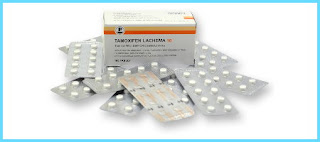Tamoxifen, raloxifene cut breast cancer risk in half

Women at high risk can take either drug as preventive therapy, researchers in a seven-year study say.
Two drugs taken by women at high risk for breast cancer — tamoxifen and raloxifene — both reduce the risk of the disease by about 50% in high-risk post-menopausal women while they are taking the medications, researchers said Monday. The benefits of raloxifene fall off more quickly once women stop taking them, however, and the increased benefits of tamoxifen come at a price: a higher risk of uterine cancer, blood clots and cataracts — although the absolute risks of all three remain low.
"These are relatively inexpensive drugs that reduce breast cancer by about 50% with side effects that are modest," said Dr. Gabriel N. Hortobagyi of the University of Texas M.D. Anderson Cancer Center in Houston, one of the researchers. "We need to reassess why we are not using these drugs more broadly," he said at a news conference at a meeting of the American Assn. of Cancer Research, where the results were presented.
The new results represent an extension of a clinical trial that was first reported in 2007 and allow refinement of the researchers' earlier conclusions. But the basic message is that women can confidently take either drug to sharply reduce their risk of dying from breast cancer.
"If they can't tolerate their first choice, they can take advantage of the second drug," said Dr. Larry Wickerham of Allegheny General Hospital in Pittsburgh, another researcher on the team.
The trial enrolled 19,747 post-menopausal women over the age of 35 who had an above-normal risk of breast cancer because they had breast cancer genes or a family history of the disease. While the average 60- to 64-year-old woman has about a 1.66% risk of developing breast cancer over a five-year period, the women in the study averaged twice that risk, and some had an even higher risk. (Women can calculate their own risk at http://www.cancer.gov/bcrisktool).
Women who had uncontrolled diabetes or hypertension were excluded from the trial, as were those at a high risk for stroke or blood clots.
The women were given either tamoxifen (brand name Nolvadex, also available generically) or raloxifene (brand name Evista) daily for five years.
The initial results released after the end of that five years showed that both drugs reduced the risk of breast cancer by 50%. Based on those findings, the Food and Drug Administration approved the use of raloxifene to prevent breast cancer in high-risk post-menopausal women. Tamoxifen was already approved in both pre- and post-menopausal high-risk women.
The new report, which provides an additional 21 months of follow-up, shows that the benefits of tamoxifen continued after the women stopped taking it, but those of raloxifene fell off quickly. Over the nearly seven years of the study, tamoxifen reduced risk by 50%, but raloxifene reduced it by only 38%. That translates to 247 cases of invasive breast cancer (tumors that are likely to spread beyond the breast) among 9,736 women who took tamoxifen and 310 cases in the 9,754 women who took raloxifene.
Previous studies have shown that tamoxifen provides protection for at least seven to 10 years after women stop taking the drug.
About half the women in the trial had previously had hysterectomies and were not at risk of uterine cancer. Among the rest, 65 of 4,739 women in the tamoxifen group developed uterine cancer, compared with 37 of the 4,717 in the raloxifene group.
The raloxifene group also had 28% fewer blood clots in a major vein and 20% fewer blood clots in the lungs, but the absolute number of events was low in both groups.
The fact that raloxifene has fewer side effects may induce more women to adopt preventive therapy, said Dr. Jack Jacoub, an oncologist at Memorial Care Cancer Institute at Orange Coast Memorial Medical Center in Fountain Valley, who was not involved in the research.
In the United States, "we have actually had difficulty getting women to accept preventive measures for breast cancer, and the primary deterrent has been the toxicity" of tamoxifen, Jacoub said. If these results are presented to women properly, "I think we will see more women receiving this therapy."
The study was funded by the National Cancer Institute, which provides more information about the results at http://www.cancer.gov/newscenter/STARresultsQandA.














Post a Comment